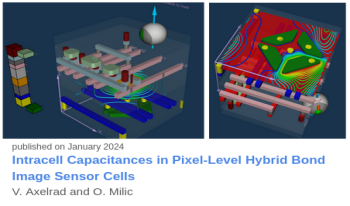
Accurate coupling capacitances are a key part in the design of modern image sensor cells due to their high speed requirements, large number of active devices and interconnects, and complex inter-layer dielectric structure. Automation of 3D structure creation integrated with the design flow as well as speed and robustness of capacitance calculation are crucial for a seamless design and optimization flow. Periodicity of image sensor arrays necessitates availability of periodic boundary conditions. High structural complexity (many layout elements, many metal interconnect levels and many dielectric layers) demands efficient numerics for reasonable runtimes. We apply a new integrated software package CellCap3D to the calculation of image sensor cell capacitances with the specific example application of comparing a Pixel-Level Hybrid Bonding (PLHB) cell to its conventional counterpart where hybrid bonds are only utilized along the periphery of the die. PLHB is a recently proposed approach which introduces an electrical contact between light-sensing (bottom) die and upper die for every pixel. A hybrid-bond, in essence a small-pitch, small-size Cu-Cu contact, now allows addition of extra MOS devices and capacitors to the individual pixel, thus greatly expanding imager functionality and performance. Additional benefit is achieved in simplification of the manufacturing of the light-sensing die. A reduction in the number of manufacturing steps, also reduces the chance of defect introduction. The architecture of the simulation system, some key components and numerical aspects are discussed in this work. The software produces a complete capacitance matrix for a typical image sensor cell with 5-7 interconnect layers in minutes on a standard Linux machine. Lithographic distortions of layout patterns, as demonstrated in the example in this work, can be optionally included for more physically accurate capacitances. Misalignment of mask layers or bonded wafers relative to each other can be considered for its effects on coupling capacitances. Periodic boundary conditions can be used for periodically repeated image sensor cells, avoiding the need to simulate an array of cells to provide the correct electrostatic environment for one cell.